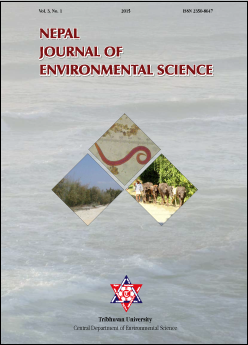Parasitic burden in high altitude wild ruminants: Himalayan Tahr (Hemitragus jemlahicus Smith, 1826) and Barking Deer (Muntiacus vaginalis Boddaert, 1785) of Rara National Park, Nepal
DOI:
https://doi.org/10.3126/njes.v3i0.22727Keywords:
Helminthes, Mammals, Eimeria, Rara National ParkAbstract
Parasites of two high altitude ruminants Himalayan Tahr (Near Threatened) and Barking Deer (Vulnerable) were examined from the Rara National Park, located at 3000 – 4000 m altitude of Nepal, for the first time. A total of 51 faecal samples, 17 from Himalayan Tahr and 34 from Barking Deer were collected in the month of May/June 2012 and 2013. Parasites were found in all the samples of Himalayan Tahr and 33 samples (97.06%) of Barking Deer. Coccidian oocysts (Eimeria sp.), eggs of cestodes (Moniezia sp.) and gastrointestinal nematodes (Strongyloides sp., Trichuris sp., Oxyuris sp., Ascaris sp., Trichostrongylus sp. and Haemonchus sp.) and bronchopulmonary nematode larvae (Dictyocaulus sp. and Muellerius sp.) were identified by means of coprological techniques. Himalayan Tahrs were found to be highly infected with Eimeria sp. (88.24%) and Moniezia sp. (70.59%) compared to Barking Deers, Eimeria sp. (73.53%) and Moniezia sp. (47.06%). In Himalayan Tahr, prevalence of Oxyuris was found to be highest (88.24%) among various nematode parasites followed by Stongyloides sp. (64.71%), Ascaris sp. (52.94%), Trichostrongylus sp. (11.76%), Dictyocaulus sp. (11.76%), Muellerius sp. (11.76%) and Haemonchus sp. (5.88%) while in Barking Deer, 26 (76.47%) samples were found to be positive for nematode parasites. Among the nematode eggs examined, Oxyuris revealed highest prevalence (70.59%) followed by Ascaris sp. (17.65%), Trichuris sp. (8.82%), Dictyocaulus sp. (8.82%) and Haemonchus sp. (2.94%). Present findings highlight that the parasitic diseases are posing considerable threat in the conservation of wild life in Nepal.
Downloads
Downloads
Published
How to Cite
Issue
Section
License
This license enables reusers to distribute, remix, adapt, and build upon the material in any medium or format for noncommercial purposes only, and only so long as attribution is given to the creator.

